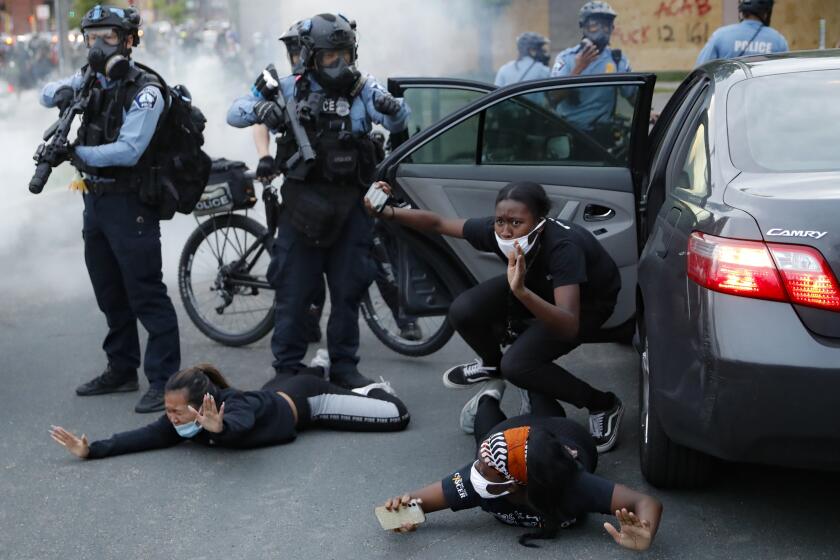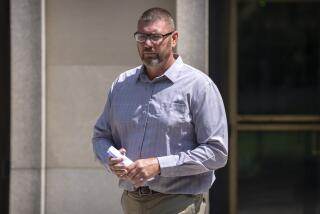Why veterans of the military and law enforcement joined the Capitol insurrection

- Share via
An Air Force veteran from Southern California and ardent conspiracy theorist bent on war against the government. An Army psychological operations officer at Ft. Bragg, N.C. A decorated, retired Air Force officer of 18 years from Texas who served in Afghanistan and Iraq.
The deadly riot in the U.S. Capitol on Jan. 6 attracted a variety of far-right extremists who shared a devotion to President Trump and his insistence on a false belief that the November election had been stolen from him through fraud.
Many rioters also had something else in common as they sought to upend the government in an insurrection that bristled with Confederate flags, racist symbols and conspiracy theories: They were ex-members of the military and police or actively employed by the armed services and law enforcement.
“It’s an incredibly disturbing trend,” retired U.S. Army Col. Jeffrey D. McCausland, a professor of national security at Dickinson College and former dean at the U.S. Army War College, said in an interview. “These are people who are supposed to uphold the Constitution and the law, yet they were doing the exact opposite.”
Since the Capitol attack, which left five people dead, including a Capitol Police officer and an Air Force veteran turned QAnon extremist, law enforcement authorities, journalists and amateur internet sleuths have scoured images, videos and arrest reports to identify those who were in the crowd.
The participants included members of the Oath Keepers, which recruits from former police and veterans, and the Three Percenters, who wear patches and carry flags with the Roman numeral III. Photos show that another anti-government group, the Boogaloo Bois, was also in Washington.
Race double standard seen by many observers as rioters storm U.S. Capitol
The military and law enforcement ties among some rioters rattled U.S. officials ahead of more possible violence.
The Joint Chiefs of Staff this week issued a memo to the military condemning the attack as “a direct assault on the U.S. Congress, the Capitol building and our Constitutional process.”
The Joint Chiefs, which is made up of the eight top branch generals, told service members that their jobs were to “support and defend the Constitution. Any act to disrupt the Constitutional process is not only against our traditions, values and oath; it is against the law.”
The letter was addressed to the joint force, which covers the 1.3 million active-duty service members. It also includes 811,000 National Guard members and reservists.
Thousands of people took part in the violent insurrection at the Capitol as Congress certified electoral college votes confirming a November election victory for President-elect Joe Biden, who takes office next week. Federal officials have pressed dozens of charges and said they will file more before planned armed rallies in Washington and state capitols over the weekend.
One flier shared in right-wing message threads on social media after the Capitol attack instructs Trump supporters to “come armed” in front of legislative houses Sunday, saying, “When democracy is destroyed, refuse to be silenced.”
Those calls for action have grown after the U.S. House of Representatives voted 232 to 197 on Wednesday to impeach Trump for the second time.
People associated with the right-wing groups “are like dogs backed into a corner and have no option but to fight,” said Joe Biggs, an Army veteran and Florida-based organizer for the Proud Boys, a far-right extremist group that counts white supremacists among its members and encourages violence. Biggs was in Washington on Jan. 6 and said he planned to avoid weekend rallies.
The military and police training shared by many on the far right present a dangerous dilemma for law enforcement seeking to quell riots and protests, especially since many followers invoke the Revolutionary War and see themselves as patriots.
“We take three months to plan an event,” Biggs said on a podcast last month. “It’s like, you’re literally planning to go into a combat zone. It’s not just like, ‘Hey man, we’re going to D.C., we’re going to Portland.’ It’s like: ‘All right, we’re going to Portland. I need satellite imagery. I need to talk to people on the ground. I need them to scout out these alleyways…. When we have an escape route, we have four or five ways in and out, in case police close things off or whatever.’”
Those in the Washington mob included 35-year-old Ashli Babbitt, an Air Force veteran from San Diego whom police shot dead as she was among armed rioters forcing their way through the Capitol.
Air Force veteran Ashli Babbitt opined on gun laws and border security on social media, then bought into QAnon conspiracy theories before joining pro-Trump insurrectionists to storm the U.S. Capitol, where she was shot dead by police.
Another retired member of the Air Force, Larry Rendall Brock Jr., was arrested Sunday in Texas and charged with unlawfully entering a restricted building, violent entry and disorderly conduct in federal court in Washington after photographs showed him on the Senate floor in a military-style helmet, black-and-green camouflage vest and tactical vest while holding zip-tie handcuffs.
Video now removed from social media showed 45-year-old Adam Newbold, who the Navy confirmed is a retired Navy SEAL, saying how proud he was of what happened in the nation’s capital. He posted the video from a car as he returned to Lisbon, Ohio.
Police officers from Los Angeles, Pennsylvania, Texas and Washington state, and the police chief of Troy, N.H., were in Washington on Jan. 6, as was a firefighter from Sanford, Fla. On Wednesday, federal officials arrested and charged two Rocky Mount, Va., officers with unlawfully entering a restricted building, violent entry and disorderly conduct.
In the attack’s aftermath, researchers and federal investigators have raised questions about how and why so many of those sworn to uphold the Constitution have become involved with dangerous extremist groups.
Kurt Braddock, a professor at American University who has written extensively on extremist groups, said that in recent years greater numbers of ex-military and law enforcement members are becoming involved with extremist groups, which he said provide “a sense of identity and direction.”
“Their past experiences were almost entirely based on being part of a collective unit designed to protect something. The propaganda of the far right makes this same promise — that you can find brotherhood and belonging in a group with a purpose,” Braddock said.
There are 19.5 million veterans in the country, according to the Department of Veterans Affairs. The federal government has not done a comprehensive study of how many have joined extremist causes, though experts said the vast majority do not.
The history of extremism, law enforcement and the military goes deep in the U.S. Former Confederate officers founded the Ku Klux Klan in the 19th century. In the 1970s, the Klan operated openly at Marine Corps Base Camp Pendleton. In 1995, Gulf War veteran Timothy McVeigh and accomplice Terry Nichols bombed the Alfred P. Murrah Federal Building in Oklahoma City.
Analysts say extremist elements have ebbed and flowed in policing and the armed services as more Americans have embraced or moved away from violent ideologies, in part influenced by economic downturns and political changes, such as racist resistance to the 2008 election of Barack Obama as the first Black president in the U.S.
Many in law enforcement have seen a rise in caustic rhetoric by current and former colleagues.
Caesar Alvarez, a former sheriff’s deputy in rural New Mexico, said that in the last four years he’s seen increased vitriol being spewed among current and former law enforcement officers on social media.
“Statewide, like in most places, law enforcement is pro-Trump, pro-right wing,” Alvarez said. “There are moments in reading some of this stuff, you stop and think, ‘Are these guys committed to upholding the law or Trump?’”
In 2009, the Department of Homeland Security apologized to veterans groups after releasing a controversial report that said extreme right-wing groups could be recruiting from disgruntled veterans who had served in Iraq and Afghanistan.
Civil rights groups have since criticized screening measures in the military that do not outright ban white supremacists. (“Mere membership in a white supremacist group is not prohibited,” Robert Grabosky, deputy director of the Air Force Office of Special Investigations, said at a February hearing of the Subcommittee on Military Personnel of the House Armed Services Committee.)
Some militias recruit specifically among veterans and former police officers. The Oath Keepers is one of them. Its name comes from the oaths its members took as law enforcement and military. The group’s founder, former Army paratrooper Stewart Rhodes, joined the Trump rally last week but has said he did not enter the Capitol or confront police.
Rhodes did not respond to calls from The Times for this article. In an interview last week with The Times, he called the presidential election a “sham” and said there were “pissed-off patriots that are not going to accept their form of government being stolen.”
The Oath Keepers, which also encouraged its members to patrol polling sites in November, has been tied to several “stop the steal” pro-Trump rallies since then. Ahead of one of those demonstrations last month in Washington, Rhodes boasted about those with law enforcement backgrounds in his group.
“The leftist terrorists know our police go armed and they don’t know which among the Oath Keepers they are looking at are police,” he wrote on the Oath Keepers website, which has since gone offline. “We always mix in our police with our military members.”
Before the Capitol attack, another attempt on a legislative building took place in the spring in Michigan when armed anti-lockdown groups converged on the Michigan Capitol to protest coronavirus-related businesses restrictions.
Though several men and women entered the statehouse in Lansing, including members of the Michigan Home Guard militia, there were no deaths or major violence. Months later, state and federal law enforcement charged 13 men in a plot to kidnap Democratic Michigan Gov. Gretchen Whitmer and put her on trial for the lockdown measures. Several were members of a group called the Wolverine Watchmen.
After Twitter, Facebook and other major social media companies this week banned or suspended Trump’s account and right-wing pages for inciting violence, many militias have migrated to alternative networks such as Gab, Zello, CloutHub and MeWe. Another, Parler, has effectively shut down after Apple and Google banned it from their app stores and Amazon cut off its web hosting service.
Jim Murphy, a 73-year-old county commissioner and Army veteran in Green Bay, Wis., is among those who has begun to migrate his accounts. He runs a chapter of the Black Robe Regiment, an armed Christian offshoot of the tea party that’s named after clergy who joined the American Revolution. Its 300 members, mostly in Wisconsin, used to talk on a Facebook group before the platform banned groups spreading false information about the presidential election.
Now, Murphy uses MeWe, a Culver City-based social media network. On a MeWe group called “Fight Smart Wisconsin,” Murphy posted this week about going beyond “spiritual warfare” in a battle against liberals.
Murphy, who said he did not attend the riot in Washington, declined to comment when reached for an interview. In posts on his MeWe group, he described his views as an extension of his Army oath:
“‘We the people’ have a responsibility to be the masters of our courts and Congress and not their servants as we’ve been lately. They are there to serve us and maintain our liberties and if they fail to do so, they need to be removed.”
Kaleem and Lee reported from Los Angeles. Times staff writers Molly Hennessy-Fiske in Houston and Richard Read in Seattle contributed to this report.
More to Read
Sign up for Essential California
The most important California stories and recommendations in your inbox every morning.
You may occasionally receive promotional content from the Los Angeles Times.

















